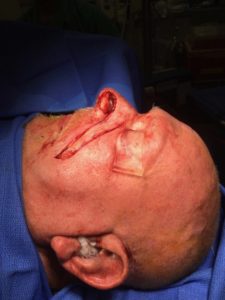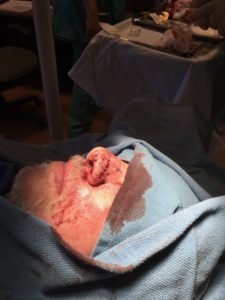| Cancer reconstruction |
Repair of facial cancer defects that have been created using the Mohs technique often utilize healthy adjacent skin flaps or skin grafts. Large facial cancers occasionally need to be repaired using free tissue transfer, ie skin, muscle, and/or bone from a different part of the body brought to fill the facial defect. |
| Cleft lip repair |
Surgical correction of the cleft lip birth deformity. Typically, this procedure is performed around 3-6 months of age, and commonly involves repairing nostril asymmetry (tip rhinoplasty) as well as the lip deformity. |
| Cleft palate repair |
Surgical correction of the cleft palate birth defect. The procedure is usually perfomed around 9-12 months of age. In addition to repairing the cleft in the roof of the mouth, ear tubes are commonly placed during the procedure to help prevent ear infections. |
| Facial paralysis |
Surgery to improve the facial deformity caused by facial paralysis. Various methods are utilized with the goal of improving facial symmetry and restoring facial animation. Small weights are frequently placed in the upper eyelid to help prevent eye dryness. |
| Facial trauma reconstruction |
Correction of facial fractures and/or facial lacerations, commonly suffered during motor vehicle accidents, fights, domestic violence, athletic events, animal bites, etc….Traumatic facial fractures frequently involve the jawbone, cheekbone, the eye socket, or the brow and require realignment of the bone segments and fixation for proper healing. Traumatic facial lacerations can cause scarring, facial nerve damage, salivary duct transection, tear duct injury, or even loss of a body part (ear avulsion). |
| Microtia repair |
Surgical correction of a congenital missing ear. An ear is created using a cartilaginous framework fashioned from rib cartilage (stage I), and subsequently refined by creation of an ear lobe (stage II), and creation of a crease behind the new ear (stage III). |
| Scar revision |
Surgery to camoflauge facial scars. |


Posted by:
on July 26th, 2013

